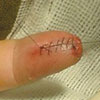Techniques for Tightening Loose Sutures



Editor's note: In a previously published Practical Pointer (CONSULTANT, August 2005), D. Brady Pregerson, MD, of Los Angeles proposed a method for tightening loose stitches after the clinician has finished suturing. He recommended running a loop between the first and last stitch on top of the skin, then cinching up both ends and tying off. We received the following comments on Dr Pregerson's suggestion from Charles Cusumano, PA-C:
- I have a simple solution to the problem described by Dr Pregerson. I have found that loose sutures can be prevented by doing a running locking suture. This maintains tension on the suture material, is simple to do, and obviates the need to "buff up" the repair after the fact.
Dr Pregerson responded to Mr Cusumano as follows:
- I like this idea as well. I sometimes use running locking sutures in wounds with excessive bleeding, such as large scalp wounds in trauma patients that must be closed promptly. However, running locking sutures probably have some minor tension and blood flow effects. Thus, I recommend asking a plastic surgeon whether any adverse cosmetic effects might result from this type of repair.
We posed this question to Murad Alam, MD, assistant professor of dermatology and otolaryngology and chief of cutaneous and aesthetic surgery at Northwestern University's Feingold School of Medicine in Chicago. His response follows.
- Running locked sutures can be an effective, affordable, and rapid means of achieving hemostasis. When hemostasis is hard to achieve even with this type of suture, individually knotted simple interrupted sutures or locked simple interrupted sutures may be used. Another method for achieving hemostasis (on areas such as the scalp or back) is to use thicker gauge suture material that can be tightened more effectively without breaking.
The main problem with running locked sutures is that if they are cinched very tight, visible "track marks" from the superficial suture may be unavoidable and persistent. On the face, such marks may be cosmetically unacceptable. Thus, although closure with running locked sutures may be acceptable on the scalp, on the face other methods of limiting bleeding—such as electrocoagulation with portable hyfrecation—are usually preferable.
If the problem is not bleeding but a running suture that is too loose, a simple interrupted suture can be placed in the area of looseness. Alternatively, the entire suture can be removed, and a deep, absorbable suture can then be placed before application of new superficial running sutures. Even a single deep suture can bring the wound edges close enough together to reduce tension and, as a result, reduce the loosening of the top running suture.
Editor's note: For an in-depth, illustrated treatment of suturing techniques, see our new feature, "Primary Care Procedures: A Photo Guide,".


